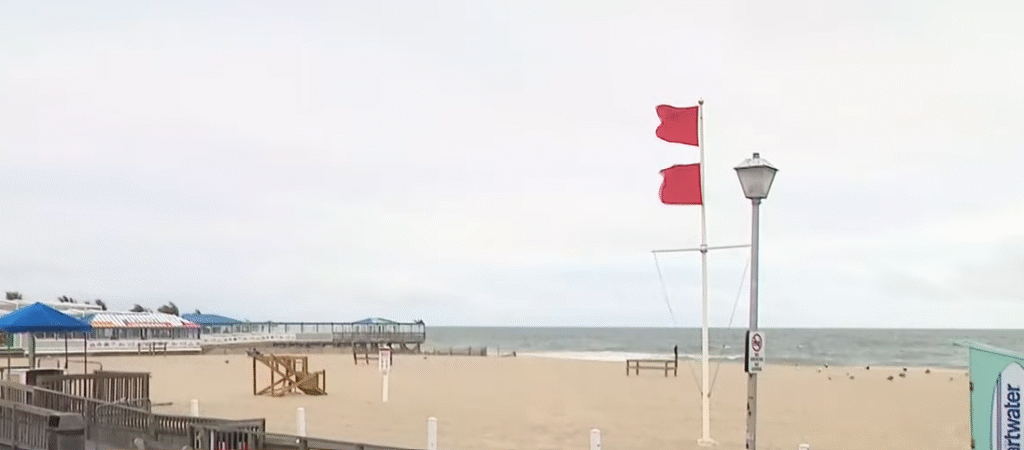Hurricane Erin passed New York with a force that was more noticeable in warnings and waves than in wind and debris, but the storm has since served as a startling reminder of how precarious the city’s connection to the Atlantic is. Lifeguards lowered their flags, beaches throughout Long Island and the five boroughs were closed to swimming, and families looking for a final taste of summer were left gazing out at a restless and intimidating sea.
The closures were especially helpful in preventing fatalities, despite being inconvenient for tourists. Erin’s rip currents were some of the strongest in recent summers, dragging even experienced swimmers into danger. Hundreds of rescues in North Carolina earlier this week served as a warning of what might have happened in New York if nothing was done, officials said, describing their choices as remarkably successful.
The storm was extraordinary in size but never reached land. Because Erin’s tropical storm-force winds could reach over 300 miles from its center, it was able to reach almost every state on the East Coast. High tides in the Rockaways, road flooding along Long Island’s coast, and close watch for seepage at subway entrances in low-lying neighborhoods were all consequences for New York. The city showed how layers of preparation can greatly reduce panic, and it has significantly improved since Hurricane Sandy’s destruction.
| Hurricane Name | Hurricane Erin |
|---|---|
| Year Active | 2025 |
| Category | Category 2 (peaking as Category 3 offshore) |
| Max Sustained Winds | 110 mph (177 km/h) |
| Closest Approach to New York | August 21–22, 2025 (offshore, but with heavy surf and flooding risk) |
| Areas Impacted | North Carolina’s Outer Banks, Mid-Atlantic Coast, Long Island, New York City |
| Main Effects in New York | Beach closures, dangerous rip currents, flooding in low-lying areas |
| Historic Reference | Hurricane Erin (2001) – longest-lived hurricane of its season |
| Climate Context | Warmer oceans fueling faster hurricane intensification |
| Source | AP News – Hurricane Erin |

Erin’s swirling clarity captured the public’s attention in satellite photos taken from the International Space Station. The fact that astronauts shared views that seemed particularly clear highlights how storms of this magnitude are both natural wonders and humanitarian issues. On the ground, Virginia Beach surfers praised Erin as a gift, describing the waves as “absolutely nuts” and enjoying the kind of waves that competitors typically look forward to. This dichotomy, which encapsulated the dual nature of hurricanes in contemporary society, was recreation for some and restriction for others.
An additional dimension was added by celebrity voices. Greta Thunberg and Leonardo DiCaprio, two environmentalists, stressed that storms like Erin are linked to a broader trend of sea warming rather than occurring at random. In presenting the storm as proof of change necessitating long-term adaptation rather than merely a disruption, their remarks were especially creative. These reminders made the connection between the urgency of closed beaches and the larger discussion of climate resilience.
Erin was a test as well as a headache for companies. While passengers were irritated by cruise lines’ decision to divert ships from New York and Bermuda, it was a very effective way to guarantee safety. While coastal homeowners once again fortified their properties, some reported that insurance premiums were rising more quickly than the tides themselves, and hoteliers in beach towns reported cancellations. Despite being less severe than a direct hit, the storm’s economic impact was nonetheless felt by sectors that depended on August tourism.
Erin may have the biggest influence on perception, though. Even an offshore hurricane can cause disruptions to daily life, a reminder to New Yorkers who tend to disregard storm warnings. Precautionary inspections, changes to ferry schedules, and brief power outages in low-lying areas all contributed to delays in the subway, demonstrating the interdependence of urban systems. Manhattan’s routines can be upset by a storm without it having to hit it directly.
That being said, resilience was clearly demonstrated. Long Beach volunteers visited senior citizens, while neighbors in coastal Queens assisted each other with sandbagging driveways. These tales demonstrate how storms can promote unity, despite frequently being overshadowed by the drama of nature itself. They emphasize that being collectively prepared involves more than just the infrastructure of cities; it also involves human networks that are incredibly dependable during times of crisis.
While scientists continue to exercise caution in their predictions, they increasingly confidently identify one trend: warmer Atlantic waters are causing hurricanes to intensify more quickly. The swift intensification of Erin prior to its coastal brush is remarkably reminiscent of patterns observed in storms during the previous five years. Weather experts are calling for quicker response systems as a result, and locals are admitting that what used to seem like uncommon occurrences are now becoming more frequent.
What, therefore, does Erin portend for the future of New York? It points to a future characterized by adaptation as opposed to denial. Despite being under construction, the city’s flood defenses held up well. The decision-making process was significantly better and faster than it was ten years ago. Officials from the city communicated very clearly, which helped residents understand what to expect and minimized confusion. Even though none of these answers were perfect, they all demonstrated a level of maturity that is incredibly useful in minimizing harm.

